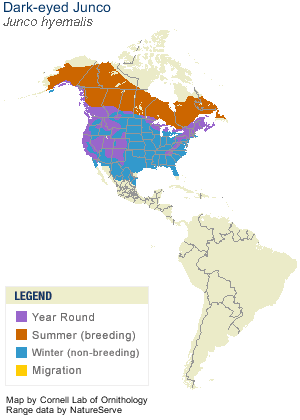The Slate Colored Junco
The Oregon Junco
The Gray-headed Junco
Pink-sided Junco
Dark-eyed Junco
Dark-eyed Juncos are neat, even flashy little sparrows that flit about forest floors of the western mountains and Canada, then flood the rest of North America for winter. They’re easy to recognize by their crisp (though extremely variable) markings and the bright white tail feathers they habitually flash in flight. One of the most abundant forest birds of North America, you’ll see juncos on woodland walks as well as in flocks at your feeders or on the ground beneath them.
-
Size & Shape
The Dark-eyed Junco is a medium-sized sparrow with a rounded head, a short, stout bill and a fairly long, conspicuous tail.
-
Color Pattern
Juncos vary across the country (see Regional Differences), but in general they’re dark gray or brown birds brightened up by a pink bill and white outer tail feathers that periodically flash open, particularly in flight.
-
Behavior
Dark-eyed Juncos are birds of the ground. They hop around the bases of trees and shrubs in forests or venture out onto lawns looking for fallen seeds. You’ll often hear their high chip notes, given almost absent-mindedly while foraging, or intensifying as they take short, low flights through cover.
-
Habitat
Dark-eyed Juncos breed in coniferous or mixed-coniferous forests across Canada, the western U.S., and in the Appalachians. During winter you’ll find them in open woodlands, fields, parks, roadsides, and backyards.
Similar Species
The Yellow-eyed Junco of extreme southern Arizona and New Mexico resembles the red-backed and gray-headed forms of the Dark-eyed Junco, but they have a staring yellow eye and a bill that is black above, yellow below. Beginning bird watchers sometimes get confused by the Black Phoebe, a flycatcher of California and the Southwest. Black Phoebes are colored very similarly to the slate-colored form of the Dark-eyed Junco, but they act very differently: they have a flycatcher's erect posture, large head, and tendency to sit still on exposed perches. Female Spotted Towhees may resemble the Oregon form of Dark-eyed Junco but have the same shade of brown on the head and back and large white spots across the wings and back.











1 comment:
It is always interesting to me to find out how many different birds you are able to find in your own backyard.
It would be interesting to count how many life birds you've found at your own home.
Post a Comment